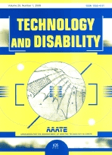
TECHNOLOGY AND DISABILITY
Scope & Guideline
Bridging the Gap Between Technology and Accessibility.
Introduction
Aims and Scopes
- Assistive Technology Development and Evaluation:
Research aimed at the design, development, and evaluation of assistive technologies that aid individuals with disabilities in daily activities, promoting independence and improving quality of life. - Accessibility and Usability Studies:
Investigations into the accessibility and usability of various technologies and environments for individuals with disabilities, ensuring that technological advancements are inclusive. - User-Centered Research and Design:
Focus on involving users with disabilities in the research and design process to create tailored solutions that meet their specific needs and preferences. - Multidisciplinary Approaches:
Utilization of interdisciplinary methodologies, including qualitative and quantitative research, to address the complex challenges faced by individuals with disabilities. - Policy and Social Implications:
Exploration of the societal and policy implications of technology use among people with disabilities, advocating for equitable access and inclusion.
Trending and Emerging
- Internet of Things (IoT) in Assistive Technologies:
There is a rising trend towards integrating IoT solutions into assistive devices, enhancing their functionality and user-friendliness for individuals with disabilities. - Virtual and Augmented Reality Applications:
An increasing focus on the use of virtual and augmented reality technologies for rehabilitation and therapeutic purposes indicates a significant shift towards immersive experiences for users. - Wearable Technology and Remote Monitoring:
The exploration of wearable devices for monitoring health and activity levels among individuals with disabilities is gaining traction, offering new avenues for personalized care and intervention. - Inclusive Communication Tools:
Emerging research around communication aids, such as Talking Mats, highlights a growing interest in fostering effective communication for individuals with diverse needs. - Multisensory and Interactive Learning Systems:
The development of multisensory systems for teaching and rehabilitation, particularly for children with learning disabilities, reflects a trend towards more engaging and interactive educational technologies.
Declining or Waning
- Traditional Rehabilitation Technologies:
There appears to be a reduction in publications focused solely on traditional rehabilitation technologies, as the field shifts towards more innovative and integrated approaches that combine multiple technological modalities. - General Awareness Campaigns:
Research centered around general awareness campaigns for assistive technology usage is less prevalent, indicating a transition towards empirical studies that evaluate specific technologies and their impacts. - Static Assistive Devices:
The focus on static assistive devices is waning in favor of dynamic, adaptable technologies that leverage smart capabilities, such as IoT, to enhance user interaction and support. - Broad Spectrum Studies without Specific Focus:
There is a decline in broad studies that do not target specific disabilities or technologies, as more research is now concentrated on tailored solutions and user-specific outcomes.
Similar Journals
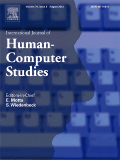
INTERNATIONAL JOURNAL OF HUMAN-COMPUTER STUDIES
Advancing Understanding in Human-Computer InteractionINTERNATIONAL JOURNAL OF HUMAN-COMPUTER STUDIES, published by Academic Press Ltd - Elsevier Science Ltd, stands at the forefront of research dedicated to the dynamic interplay between humans and technology. With a remarkable impact factor reflective of its rigorous academic standards and its prestigious ranking in the Q1 category across vital disciplines such as Education, Engineering, Human Factors and Ergonomics, and Human-Computer Interaction, this journal serves as an essential resource for researchers, professionals, and students alike. Spanning from 1994 to 2024, it showcases pioneering studies that contribute significantly to the understanding of cognitive processes, usability, and the evolving role of technology in society. Despite the absence of Open Access options, access to this journal is facilitated through institutional subscriptions, ensuring that critical findings and advancements are readily available to a global audience. By continuing to publish high-quality research, the INTERNATIONAL JOURNAL OF HUMAN-COMPUTER STUDIES plays a crucial role in advancing the field, fostering innovation, and guiding future research directions.

Journal of Usability Studies
Transforming usability studies for a better user experience.The Journal of Usability Studies, published by the USERS EXPERIENCE PROFESSIONAL ASSOCIATION, is a pivotal platform for researchers and professionals dedicated to advancing the field of usability and user experience design. With an ISSN of 1931-3357, this journal offers a collection of peer-reviewed articles that explore innovative methodologies, emerging technologies, and applied research in usability studies. Though it operates under a traditional access model, the journal remains dedicated to fostering a detailed understanding of how users interact with systems and products. The Journal of Usability Studies is instrumental for those aiming to enhance user satisfaction through research-backed insights, making it a vital resource for academics, practitioners, and students seeking to contribute to the evolving discourse in human-computer interaction and usability engineering.
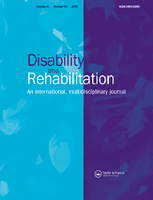
DISABILITY AND REHABILITATION
Shaping the Future of Rehabilitation Through Rigorous Scholarship.Disability and Rehabilitation, a prestigious journal published by Taylor & Francis Ltd, plays a critical role in the field of rehabilitation science. Since its inception in 1978, this journal has been dedicated to presenting high-quality research focused on improving the lives of individuals with disabilities through innovative rehabilitation techniques and healthcare solutions. With an impressive Q1 ranking in the Rehabilitation category and a Scopus rank of #24 out of 161, the journal is recognized for its significant impact and rigorous scholarly contributions, boasting an 85th percentile performance among peers. Although it operates under a subscription model, the journal remains a vital resource for researchers, healthcare professionals, and students seeking the latest insights and developments in the realm of disability and rehabilitation. Covering a broad spectrum of topics, from clinical practices to theoretical advancements, Disability and Rehabilitation continues to shape the future of rehabilitation research and practice worldwide.

European Journal of Physical and Rehabilitation Medicine
Transforming Rehabilitation: Evidence-Based Strategies for Better OutcomesWelcome to the European Journal of Physical and Rehabilitation Medicine, the premier peer-reviewed journal focusing on advancements in the fields of physical therapy, sports therapy, and rehabilitation. Published by EDIZIONI MINERVA MEDICA, this journal has established itself as a leading resource since its inception in 2008, now enjoying an impressive Q1 ranking in these disciplines according to 2023 metrics. With an emphasis on rigorous research and innovative clinical practice, the journal facilitates the dissemination of high-quality, evidence-based studies, contributing to the enhancement of patient care and therapeutic strategies. As an Open Access platform since 2022, the journal widens its reach, enabling researchers, clinicians, and students across the globe to access valuable insights without barriers. Residing in Italy, the journal's focus transcends regional confines, engaging a vibrant international community aimed at improving rehabilitation outcomes. Join us in exploring the latest developments that shape the future of rehabilitation sciences.

Journal of Vocational Rehabilitation
Advancing the Future of Vocational RehabilitationJournal of Vocational Rehabilitation is a leading academic journal published by IOS PRESS, focusing on the critical intersection of vocational rehabilitation and occupational therapy. With an ISSN of 1052-2263 and an E-ISSN of 1878-6316, this esteemed journal has been committed to advancing knowledge in this essential field since its inception in 1991. Located in the Netherlands, the journal is recognized for its impact, holding a Q2 rank in Occupational Therapy and a Q3 rank in Rehabilitation as of 2023. The Journal of Vocational Rehabilitation serves as a vital resource for researchers, professionals, and students alike, facilitating the dissemination of innovative research, evidence-based practices, and comprehensive reviews that drive progress in vocational rehabilitation. Through its rigorous peer-review process, the journal ensures high-quality publications, making it a cornerstone for those seeking to enhance their understanding and application of vocational rehabilitation principles.
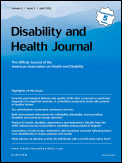
Disability and Health Journal
Illuminating the intersections of health and disability.The Disability and Health Journal, published by Elsevier Science Inc, is a leading peer-reviewed platform that focuses on the interconnections between disability and health management. With its impact factor underscoring its significance at Q1 in both Medicine and Public Health, Environmental and Occupational Health, this journal stands out for its comprehensive analysis and dissemination of research covering the range of public health issues affecting individuals with disabilities. Spanning research from 2008 to 2024, it provides a rich collection of studies that aim to enhance understanding and improve practices in the field. As a reference for researchers, practitioners, and students alike, the journal promotes the sharing of innovations and evidence-based methodologies that advance disability studies. The journal operates under a traditional access model, allowing for a broad readership while maintaining high academic standards. With a Scopus rank of #78 out of 665 in its category, the Disability and Health Journal is essential for anyone seeking to contribute to or stay informed about major developments in disability and health research.

Journal of Postsecondary Education and Disability
Bridging Research and Practice for Equity.The Journal of Postsecondary Education and Disability (ISSN: 2379-7762; E-ISSN: 2328-3343), published by the Association on Higher Education and Disability (AHEAD), stands as an essential resource for researchers, professionals, and students dedicated to the study and enhancement of postsecondary education for individuals with disabilities. This esteemed journal aims to foster a deeper understanding of accessibility issues, inclusive practices, and policy development within higher education contexts, thereby facilitating academic discourse and innovative solutions. With its commitment to advancing knowledge and promoting best practices, the journal serves as a pivotal platform for sharing empirical research, theoretical discussions, and case studies that address the multifaceted challenges faced by students with disabilities. By providing high-quality content that bridges research and practice, the Journal of Postsecondary Education and Disability plays a critical role in shaping inclusive educational environments and empowering diverse student populations.
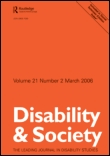
DISABILITY & SOCIETY
Exploring the intersection of disability, culture, and policy.DISABILITY & SOCIETY is a peer-reviewed academic journal published by Routledge Journals, Taylor & Francis Ltd, which has established itself as a leading platform for research in the fields of disability studies, social policy, and health professions. Since its inception in 1994, the journal has continuously contributed to scholarly discussions and practice, focusing on the social, cultural, and institutional factors that impact the lives of disabled individuals. The journal is highly regarded, holding a Q1 ranking in categories such as Health Professions and Social Sciences according to the 2023 metrics, indicating its significant influence and reach within the academic community. With its broad scope and emphasis on interdisciplinary approaches, DISABILITY & SOCIETY serves as an invaluable resource for researchers, professionals, and students alike, fostering a comprehensive understanding of disability in society and promoting inclusive practices. The journal is committed to providing insightful articles that encourage rigorous academic debate and inform policy development, making it essential reading for anyone involved in disability research and activism.
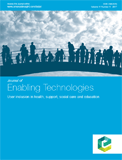
Journal of Enabling Technologies
Driving Progress in Computer Science and RehabilitationThe Journal of Enabling Technologies, published by EMERALD GROUP PUBLISHING LTD, stands as a pivotal resource within the realms of Computer Science Applications, Health (Social Science), and Management of Technology and Innovation. Established in 2017 and converging towards its 2024 target, the journal has garnered significant recognition, reflected in its Q3 classification in multiple categories for 2023 and a commendable Q2 ranking in Rehabilitation. It holds respectable standings in Scopus rankings, notably positioning itself at the 38th percentile in Rehabilitation and 71st in Health Social Sciences. Aimed at promoting knowledge and innovation, the journal serves as an essential platform for researchers, professionals, and students, enabling them to explore advancements, share insights, and foster interdisciplinary collaboration. Although it does not offer open access, its impact factor and authoritative standing in the field underscore its importance for anyone dedicated to enhancing technology utilization across these vital sectors.

mHealth
Exploring the Future of Health TechnologymHealth is a pivotal peer-reviewed journal published by AME PUBLISHING COMPANY, focusing on the evolving field of mobile health technologies and their impact on public health and health informatics. With an E-ISSN of 2306-9740, this journal, based in China, operates under an open access model, ensuring widespread dissemination and accessibility of published research. As of 2023, mHealth is recognized in the Q2 category for both Health Informatics and Public Health, Environmental and Occupational Health, reflecting its significant contribution to vital areas of contemporary health research. The journal's Scopus rankings further enhance its reputation, situating it in the 74th percentile for Public Health and 64th for Health Informatics, making it an essential resource for researchers, professionals, and students eager to explore the intersection of technology and health outcomes. Covering a diverse range of topics from 2019 through 2024, mHealth aims to foster innovation and knowledge exchange among practitioners and scholars alike.